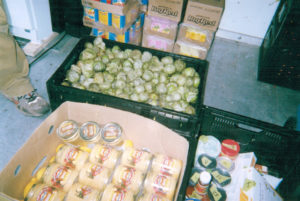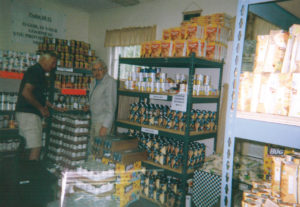April 14, 2020 at 11:09 pm

SITUATIONAL POOR – A person fits into a situational category of poverty when s/he lands in a situation created by an event such as a hurricane, fire, flood, pandemic, or other disaster which destroys the home, job, car.
Food pantries, food banks, soup kitchens are overworked in today’s pandemic world. The line of hungry people grows every time the place opens.
It’s bad enough that the line grows weekly. But, worse, many people in the line are confused, afraid. The never thought they would find themselves in a food pantry line with hundreds of other hungry, confused, afraid.
How should they act? What should they do?
What do they do with the food, once they get it home? It may be good food – both delicious and nutritious. However, it may not be anything recognizable. More often than not, pantry food doesn’t come with recipes. Super markets carry thousands of items. Food pantries carry maybe 50 different items and the labels on the cans and boxes aren’t even recognizable. The fresh produce may be organic but not be labeled as such.
So, now that the pantry food is in its new found kitchen, there is a big adjustment period involved in getting it to the table.
We are not so far removed from those people in the food pantry. They are our neighbors, friends, co-workers, relatives, classmates.
And, truth be told, we are all confused, and afraid.
Even though you may not be in the line, there are definitely things you can do. For starters, send a check to a food pantry, soup kitchen, or food bank in your area. If you don’t know where to send the check, look up an organization called:
Feeding America.
Feeding America is glue holding the food pantry world together. If that doesn’t work for you, search out: Regional Food Bank of Northeastern New York.
The Regional Food Bank of Northeastern New York, along with the Food Bank of the Hudson Valley, do an amazing job of making delicious, nutritious foods available to those who need it most.
These two food banks are only two in a large network of food banks located throughout the country. If you seeking a feeding facility in another part of the country, these organizations can guide you to one in the area best for you.
If you are uncomfortable sending money, this might be a good time to organize a food drive.
I wrote three action guides which list suggestions and options which are easy-to-understand and read. You can get these action guides free. Email me your mailing address and I’ll get your copies in the mail right away. I’m not even charging postage and handling.
Email me your mailing address to thurmangreco@gmail.com.
The guidelines and suggestions are practical. I feel confident you’ll discover practical things you can do to help on one of the action guides.
Thank you for caring.
Thanks for reading this article. Please refer it to your preferred social media network.
Thurman Greco
Woodstock, New York



November 14, 2018 at 12:27 am

DONATE FOOD TO A FOOD PANTRY
When you purchase groceries, buy a few extra jars or cans of food and take them to your neighborhood food pantry.
Peanut butter is my favorite choice. It’s shelf stable so needs no refrigeration. That makes it good for homeless people. It doesn’t spoil quickly so it can be used by a household with one or ten people. It doesn’t require a lot of chewing so it’s good for a person with no teeth. In short, peanut butter is a perfect food choice for a food pantry.
However, if you would rather choose another item, go with whatever you want to give. Whatever you choose, it will be selected by someone shopping in the pantry.
CLEAN OUT YOUR KITCHEN CABINETS
Give the unused items to your local food pantry.
HOST A FOOD DRIVE
Invite your friends and neighbors to help you collect food for your local food pantry.
DONATE CLEAN EGG CARTONS AND REUSABLE SHOPPING BAGS TO YOUR FOOD PANTRY.
Food pantries are always in need of shopping bags and egg cartons. Eggs coming to a food pantry usually come in cases – without the cartons.
Shopping bags are not usually found on food pantry shopping lists.
CLEAN OUT THAT CLOSET!
Take your gently used clothing and bedding to a pantry or soup kitchen for distribution. I recently learned that the clothing item most needed in shelters is socks.
I also learned that women’s shelters are always in need of bras.
In the Albany, New York, area, you can send gently used or new women’s bras to:
YWCA – Greater Capitol Region
Brava
21 First Street
Troy, New York 12180
CELEBRATE YOUR BIRTHDAY.
Invite people to a party and ask them to give donations to a food pantry instead of a gift.
GIVE A LITTLE THROUGHOUT THE YEAR.
Make a regular donation to a food pantry. This translates to sending a check or gas card every month or quarter.
CONTACT ELECTED OFFICIALS AND PERSONS OF INFLUENCE.
Motivate them to make ending hunger and homelessness a priority. Encourage them to support fair wages and benefits for workers.
READ A BOOK.
“Take This Bread” by Sara Miles, “Under the Overpass” by Mike Yankoski, “I am Your Neighbor” by David R. Brown and Roger Wright, and “I Don’t Hang Out in Churches Anymore” by Thurman Greco are four books which tell revealing stories about hungry people in America.
START A SCHOOL BACKPACK PROGRAM.
Backpack programs send food home on Friday afternoons to households where children would not otherwise eat over the weekend without the donated foods.
Thanks for reading this article! Please refer it to your preferred social media network.
Thurman Greco
Woodstock

.










